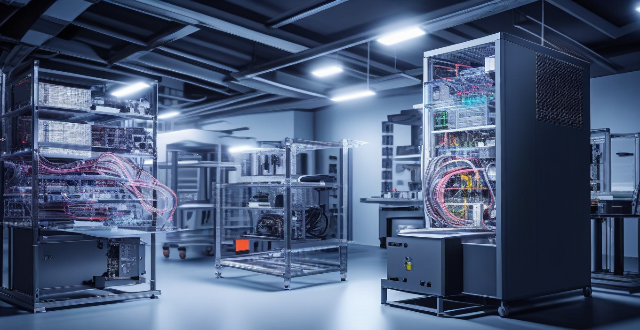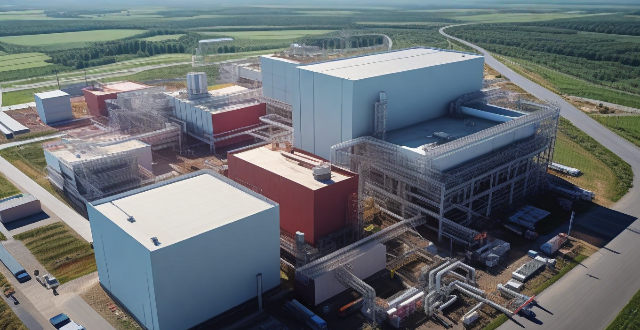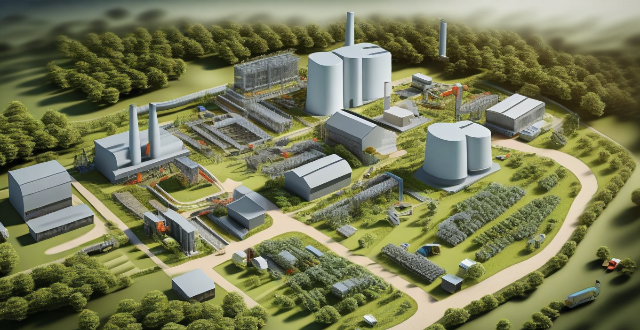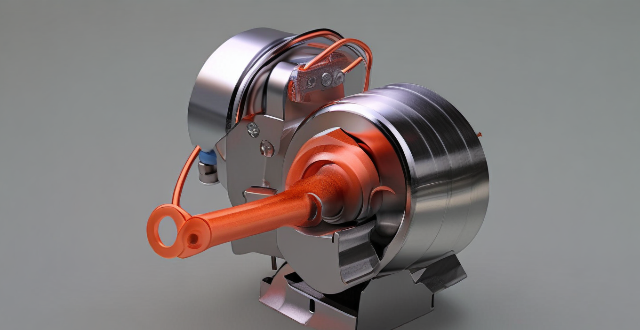Manufacturing Sustain

How has the adoption of Industry 4.0 technologies influenced energy efficiency in manufacturing ?
Industry 4.0 technologies significantly impact energy efficiency in manufacturing by enabling precision and optimization, data-driven decision making, resource management, promoting sustainability, and enhancing employee engagement. These advancements contribute to a future where smart manufacturing and sustainability are intertwined.

What is the impact of smart manufacturing on industrial energy consumption ?
Smart manufacturing, or Industry 4.0, is transforming industrial operations through AI, IoT, and robotics to boost efficiency and sustainability. One major benefit is its impact on reducing energy consumption in industries. This article discusses how smart manufacturing can aid in decreasing energy usage: 1. **Optimization of Production Processes**: Real-time data analytics and predictive maintenance techniques lead to less energy waste and higher efficiency. Sensors monitor equipment performance to reduce downtime and energy consumption during repairs. 2. **Automation and Robotics**: Replacing manual labor with automated machines and robots results in higher precision and consistency while minimizing energy usage. Smart technologies also enable better resource allocation for reduced energy consumption. 3. **Energy Management Systems (EMS)**: EMS are crucial for monitoring and controlling energy consumption. They provide insights into energy usage patterns, allowing companies to identify areas where energy savings can be achieved. Implementing energy-saving measures based on EMS data can significantly cut energy consumption and costs. 4. **Renewable Energy Sources**: Smart manufacturing promotes the use of renewable energy sources like solar and wind power to reduce dependence on non-renewable sources like fossil fuels. This contributes to environmental sustainability by lowering greenhouse gas emissions. Integrating smart grids into industrial facilities further optimizes energy distribution and enhances efficiency. Overall, smart manufacturing significantly impacts industrial energy consumption by optimizing production processes, incorporating automation and robotics, implementing energy management systems, and promoting renewable energy sources. These advancements not only reduce energy waste but also contribute to environmental sustainability by lowering greenhouse gas emissions.

How has automation changed the manufacturing industry ?
Automation has significantly impacted the manufacturing industry by increasing productivity, reducing costs, enhancing safety, and providing flexibility. It has also led to improved data collection and analysis but has shifted labor force needs and raised environmental considerations.

How do safety regulations affect the manufacturing industry ?
Safety regulations are critical in manufacturing for worker safety, environmental protection, and product quality assurance but can increase costs and administrative burden while potentially slowing innovation.

What is the role of artificial intelligence in modern rocket technology ?
The article discusses the pivotal role of Artificial Intelligence (AI) in revolutionizing various aspects of modern rocket technology. It explores how AI is transforming design and manufacturing processes, including computational fluid dynamics simulations, machine learning-driven material science, and automated manufacturing. The text also delves into AI's contributions to launch and orbital insertion, such as predictive maintenance, trajectory optimization, and real-time decision making. Furthermore, it highlights AI applications in on-orbit operations like autonomous navigation, swarm intelligence, and fault detection and recovery. The article concludes by discussing future implications of AI in deep space exploration, reusable rocketry, and collaborative robotics, emphasizing its potential to make space missions safer, more efficient, and cost-effective.

Are there any environmental concerns associated with the production and disposal of DC brushed motors ?
The article discusses the environmental concerns associated with DC brushed motors, including high energy consumption, material extraction and processing, manufacturing processes, and end-of-life disposal. It suggests potential solutions such as improved efficiency, sustainable material sourcing and processing, eco-friendly manufacturing practices, and responsible end-of-life management to mitigate their impact on the environment.

In which industries are permanent magnet motors most commonly used ?
Permanent magnet motors are utilized across a wide range of industries due to their efficiency and reliability. Key sectors include the automotive industry, where they power electric and hybrid vehicles and are used in automated manufacturing. In aerospace and defense, PM motors are crucial for aircraft systems and military applications. Appliance manufacturing benefits from PM motors in household and commercial equipment. The medical sector employs them in imaging equipment and surgical tools. Manufacturing and process control use PM motors in CNC machinery and pumps/valves. Renewable energy sectors such as wind turbines and solar tracking systems also rely on these motors. Consumer electronics, including audio and visual equipment as well as toys and hobbyist products, make use of permanent magnet motors for various functions.

What are the environmental impacts of electric cars ?
Electric cars, also known as EVs (Electric Vehicles), have become increasingly popular in recent years due to their potential to reduce greenhouse gas emissions and improve air quality. However, like any other technology, electric cars also have some environmental impacts that need to be considered. In this article, we will discuss the various environmental impacts of electric cars. One of the most significant environmental benefits of electric cars is their ability to reduce greenhouse gas emissions. Compared to traditional gasoline-powered vehicles, electric cars produce zero tailpipe emissions. This means that they do not release harmful pollutants such as carbon dioxide, nitrogen oxides, and particulate matter into the atmosphere. As a result, electric cars can help reduce air pollution and improve public health. The environmental impact of electric cars also depends on the source of energy used for charging them. If the electricity used to charge an electric car comes from renewable sources such as wind or solar power, then the overall environmental impact is positive. However, if the electricity comes from coal-fired power plants or other non-renewable sources, then the environmental benefits are reduced. It is essential to ensure that the electricity used for charging electric cars comes from clean and sustainable sources. The production of lithium-ion batteries used in electric cars has some environmental impacts. The mining and processing of raw materials required for battery production can lead to water pollution, soil contamination, and habitat destruction. Additionally, the disposal of spent batteries can pose challenges as they contain toxic chemicals that can harm the environment if not disposed of properly. Recycling programs and research into alternative battery technologies can help mitigate these impacts. The manufacturing process of electric cars also has some environmental impacts. The production of electric car components requires energy and resources, which can lead to greenhouse gas emissions and other forms of pollution. However, compared to traditional gasoline-powered vehicles, electric cars generally have a lower environmental impact during the manufacturing process due to their simpler design and fewer moving parts. To fully understand the environmental impacts of electric cars, it is essential to consider their entire lifecycle, including raw material extraction, manufacturing, use, and disposal. A comprehensive lifecycle analysis can help identify areas where improvements can be made to reduce the overall environmental impact of electric cars. This may include using more sustainable materials, improving energy efficiency during manufacturing, and developing better recycling programs for spent batteries. In conclusion, while electric cars offer significant environmental benefits over traditional gasoline-powered vehicles, they also have some environmental impacts that need to be considered. By addressing these issues through sustainable practices and continued research, we can maximize the positive environmental impacts of electric cars and work towards a cleaner, greener future.

In what applications are internal rotor motors commonly used ?
Internal rotor motors, also known as rotary motors or simply electric motors, are widely used in various applications due to their ability to convert electrical energy into mechanical energy. These motors consist of a stationary component (stator) and a rotating component (rotor), which is located inside the stator. The rotor is driven by electromagnetic forces generated by the interaction between the stator and rotor windings. In conclusion, internal rotor motors play a crucial role across numerous sectors, from industrial manufacturing to domestic appliances and even critical medical equipment. Their versatility makes them an essential component in modern technology advancements.

How do fuel vehicles affect the economy, particularly in terms of employment in the oil industry ?
The text discusses the impact of fuel vehicles on employment in the oil industry. It highlights that the industry offers a range of jobs from exploration and extraction to refining, distribution, and sales. However, it also notes challenges such as market volatility, environmental concerns, and technological advances that could affect job stability in the sector. The text concludes by emphasizing the need for strategies that promote economic stability while encouraging sustainable practices and innovation.

How have businesses adapted to pandemic management measures ?
Businesses worldwide have undergone significant transformations in response to the COVID-19 pandemic, including increased adoption of remote work, changes in operations like local sourcing and automation, health and safety measures such as physical distancing and PPE, financial strategies including cost cutting and government aid, enhanced communication and marketing efforts through virtual events and content marketing, and rapid digital transformation with cloud services and data analytics. These adaptations aim to ensure business survival and operation during these challenging times while also presenting opportunities for future growth and efficiency.

Can small businesses also offer climate-friendly products ?
Small businesses can offer climate-friendly products by adopting sustainable practices and eco-friendly alternatives. They can reduce their carbon footprint, meet customer demand for eco-friendly options, save costs, gain a competitive edge, and build reputation. They can source materials sustainably, design energy-efficient products with reduced packaging, make operational changes like using green energy, and promote education about sustainability. Despite challenges like higher costs, they can seek funding, build partnerships, and educate customers to overcome these obstacles.

What is risk management and why is it important ?
Risk management is a systematic approach used by organizations to identify, assess, and prioritize potential risks that may impact their objectives. It involves implementing strategies to monitor and control these risks effectively. The goal of risk management is to minimize the probability and impact of negative events and maximize the opportunities for positive outcomes. The importance of risk management includes mitigating uncertainty, enhancing decision-making, compliance and regulatory requirements, protection of reputation, financial performance, and promoting innovation. Effective risk management is crucial for any organization looking to sustain its operations, protect its assets, enhance decision-making, maintain compliance, preserve its reputation, and improve its financial performance. It enables companies to navigate challenges proactively and capitalize on opportunities while minimizing the impact of potential threats.

How can agriculture be adapted to cope with the effects of climate change ?
Adapting agriculture to cope with climate change involves various strategies, including crop diversification, water management, soil health improvement, livestock adjustments, use of technology, agroforestry, early warning systems, education, policy support, and carbon sequestration. These measures help maintain yields, ensure food security, and sustain livelihoods amidst changing climatic conditions.

What are the key factors driving the growth of the Chinese economy ?
The growth of the Chinese economy has been driven by several key factors, including government policies and reforms, demographic dividend, globalization and export-led growth, domestic demand and consumption, and environmental sustainability and green growth. These factors have collectively contributed to rapid economic development in China over the past few decades. However, ongoing challenges such as demographic changes, environmental concerns, and global economic uncertainties require continued adaptation and innovation to sustain future growth.

Do different genres of music have varying effects on sports performance ?
Music is a powerful tool that can influence our mood, motivation, and overall performance in various activities, including sports. The question arises: do different genres of music have varying effects on sports performance? Let's delve into this topic to find out. ### Motivational Aspect - **Upbeat Music**: Fast-paced music with a high tempo, such as rock or electronic dance music, can increase energy levels and provide motivation during workouts or competitions. - **Relaxing Music**: Slow-tempo music like classical or instrumental tracks may help athletes relax and focus on their technique rather than intensity. ### Physical Response - **Heart Rate**: Upbeat music can increase heart rate, preparing the body for more intense physical activity. - **Muscle Response**: Some studies suggest that certain genres of music can affect muscle activation and coordination. ### Mental Focus - **Concentration**: Music without lyrics or with less distracting elements can help maintain focus during repetitive tasks or endurance events. - **Mental Toughness**: Aggressive or empowering music can boost mental toughness, helping athletes push through difficult moments. ### Recovery Process - **Relaxation**: Genres like ambient or yoga music can aid in recovery by reducing stress and promoting relaxation post-exercise. ### Genre-Specific Effects - **Rock/Pop**: Ideal for high-intensity workouts where an energy boost is needed. - **Classical/Instrumental**: Suitable for activities requiring precision and concentration. - **Hip-Hop/Rap**: The strong beats can serve as a rhythmic guide for exercises requiring timing and coordination. - **Electronic Dance Music (EDM)**: Suitable for interval training due to its ability to sustain high energy levels. - **Ambient/Yoga Music**: Helpful in recovery sessions by promoting relaxation and reducing tension.

How does green employment contribute to sustainability ?
Green employment, or green-collar jobs, are essential in achieving sustainability by promoting environmentally friendly practices, enhancing social well-being, and fostering economic growth through innovation and job creation. These jobs focus on renewable energy, waste reduction, sustainable agriculture, ecotourism, and more. By embracing these sustainability careers, we can build a resilient future for all.

How does global shopping contribute to economy ?
Global shopping, or cross-border e-commerce, has become a crucial aspect of the global economy. It involves buying and selling goods and services across national borders through online platforms. This phenomenon has not only revolutionized shopping but also significantly contributed to economic growth worldwide. Here are some ways global shopping boosts the global economy: 1. Increased consumer spending: Global shopping provides consumers with access to a wide range of products from around the world, leading to higher consumer spending, which is a key driver of economic growth. 2. Benefits for sellers: Businesses can reach new customers and expand their market share by tapping into international markets, increasing revenue and profitability. 3. Job creation and employment opportunities: The rise of global shopping has given birth to numerous jobs in various sectors such as logistics, customer service, marketing, and technology. 4. Boosting local economies: Local businesses can reach customers beyond their geographical boundaries by exporting their products globally, generating revenue that helps sustain their operations and contribute to the local economy. 5. Encouraging innovation and competition: The global marketplace created by cross-border e-commerce encourages businesses to innovate and improve their products to stay competitive, benefiting consumers by providing them with high-quality products at competitive prices. 6. Fostering international trade relations: Global shopping promotes cooperation between nations by facilitating trade agreements and reducing barriers to entry for businesses looking to expand internationally.

What role does protein play in a healthy diet ?
Protein is an essential nutrient that plays a crucial role in maintaining a healthy diet. It contributes to tissue growth and repair, enzyme and hormone production, immune system function, fluid balance, and energy provision. Consuming a variety of protein sources is important to ensure all necessary amino acids are obtained.

What factors affect the performance of a lithium battery ?
The performance of a lithium battery can be affected by temperature, charging rate, discharging rate, depth of discharge, age, and manufacturing quality. High temperatures and fast charging can damage the battery and reduce its lifespan, while low temperatures and slow charging can prolong the battery's lifespan but may not provide enough power for high-demand devices. High discharging rates can cause the battery to heat up and decrease in performance, while low discharging rates can prolong the battery's lifespan but may not provide enough power for high-demand devices. High DoD can lead to increased stress on the battery and a shorter lifespan, while low DoD can help prolong the battery's lifespan but may not be practical for devices that require a lot of power. Older batteries will have decreased capacity and performance, while newer batteries will have better performance and capacity. High-quality manufacturing processes can result in better performing batteries with longer lifespans, while low-quality manufacturing processes can result in poor performing batteries with shorter lifespans.

What role does cinematography play in making sports movies engaging ?
Cinematography plays a crucial role in making sports movies engaging by capturing the essence of athleticism and the drama of competition. Through the use of various filmmaking techniques, cinematographers can bring the excitement and emotions of sports to life on the screen. Here are some ways in which cinematography contributes to the appeal of sports movies: 1. Dynamic Camera Movement - Tracking shots, crane shots, and handheld shots create a sense of speed and momentum, reveal the scale of stadiums and crowds, and create an intimate, immersive experience for the viewer. 2. Creative Angles and Perspectives - Low angles make athletes appear powerful and dominant, high angles show the vulnerability or isolation of a character within a vast arena, and point-of-view shots allow the audience to see what the athlete sees, enhancing their connection to the action. 3. Lighting and Color - Contrast and shadows highlight the physicality of sport and the intensity of effort, color grading is used to convey mood, team identity, or historical eras, and backlighting creates a dramatic effect around athletes, often used in climactic moments. 4. Slow Motion and Fast Motion - Slow motion extends key moments to emphasize grace, power, or impact, while fast motion compresses time to show training sequences or build anticipation. 5. Special Effects and Visual Effects (VFX) - Chromakeying isolates athletes against different backgrounds for creative storytelling, CGI recreates historical events or enhances visually complex sports like underwater scenes, and compositing combines multiple layers of footage for dynamic scenes that couldn't be captured live. 6. Sound Design - Audio effects synch sound effects with visuals to heighten the impact of movements, and musical score supports the visuals, enhancing tension or celebration. 7. Editing Pace - Quick cuts build excitement during high-intensity moments, while long takes sustain tension during crucial plays or showcase skillful execution. 8. Storytelling through Visuals - Symbolic images use iconic sports imagery to tell stories without dialogue, and composition arranges elements within the frame to guide the audience's focus. 9. Emotional Engagement - Close-ups show facial expressions and reactions, drawing viewers into the emotional state of athletes, and environmental interaction captures interactions between athletes and their surroundings, like skimming fingers on a track or splashes in a pool. 10. Juxtaposition and Montage - Narrative montage tells backstory or parallel plotlines through a series of short, thematically connected shots, while contrast montage compares different worlds or states of mind by cutting between contrasting scenes. In summary, cinematography is not just a tool for aesthetic enhancement in sports movies; it is a language that translates the physicality, emotion, and narrative of sports into a compelling visual experience. By masterfully employing these techniques, filmmakers can transform a simple game into an unforgettable cinematic journey.

Is it necessary for employers to provide fitness facilities or subsidize gym memberships ?
As the importance of physical health and wellness becomes increasingly recognized, many employees are looking for ways to maintain an active lifestyle. One option that has gained traction in recent years is for employers to provide fitness facilities or subsidize gym memberships as part of their employee benefits package. Providing fitness facilities or subsidizing gym memberships can help employees stay healthy and energized, which can lead to increased productivity at work. Studies have shown that regular exercise can reduce fatigue, improve mood, and enhance cognitive function, all of which can contribute to better job performance. Offering fitness perks can also be a powerful tool for attracting and retaining top talent. In today's competitive job market, companies need to offer unique benefits that set them apart from their competitors. By providing access to fitness facilities or subsidizing gym memberships, employers can demonstrate a commitment to their employees' well-being and create a positive work culture that fosters loyalty and engagement. While the initial investment in setting up a fitness facility or subsidizing gym memberships may be significant, there are potential long-term cost savings to consider. By promoting a healthy lifestyle among employees, employers may be able to reduce healthcare costs associated with chronic diseases related to poor diet and lack of exercise. Additionally, reducing absenteeism due to illness or injury can also save money in the long run. However, one of the main concerns about providing fitness facilities or subsidizing gym memberships is the cost. Depending on the size of the company and the scope of the program, implementing such benefits can be expensive. Employers must weigh the potential benefits against the financial implications before making any decisions. Another challenge is ensuring that the program is accessible and convenient for all employees. If the company is located in a remote area or has multiple locations, it may not be feasible to provide on-site fitness facilities or subsidize gym memberships at nearby clubs. Additionally, some employees may prefer working out at home or participating in outdoor activities rather than using a gym. Employers must also consider legal issues when implementing fitness programs. For example, they should ensure that any fitness facilities comply with local building codes and safety regulations. They should also be aware of potential liability issues if employees sustain injuries while participating in company-sponsored fitness activities. In conclusion, while it is not absolutely necessary for employers to provide fitness facilities or subsidize gym memberships, doing so can offer several benefits including increased productivity, improved retention and recruitment efforts, and potential cost savings over time. However, employers must carefully consider the financial implications, logistical challenges, and legal considerations before implementing such programs. Ultimately, whether or not to offer these benefits will depend on each individual company's unique circumstances and priorities.

What are the challenges faced by the wind energy industry ?
The wind energy industry faces several challenges including intermittency, site selection, manufacturing issues, maintenance and reliability concerns, and environmental impact. Addressing these challenges requires innovation, policy support, and collaboration between stakeholders and communities.

How can businesses incorporate sustainability practices and raise environmental awareness among consumers ?
Businesses can promote sustainability and raise environmental awareness among consumers by implementing green practices, engaging employees and stakeholders, and leveraging marketing and communications strategies. These include using renewable energy sources, managing waste responsibly, conserving water, offering sustainability workshops, forming green teams, collaborating with NGOs and suppliers, participating in community outreach, using eco-labels, developing green product lines, publishing sustainability reports, launching green social media campaigns, blogging about sustainability, and producing video content showcasing the company's commitment to sustainability.

What potential challenges might we face when attempting to colonize another star system ?
The text discusses the potential challenges in colonizing another star system, including long-distance travel, habitability of new planets, technological hurdles, sociopolitical considerations, health and medical concerns, and economic sustainability. It emphasizes the need for international cooperation, cutting-edge research, and innovative solutions to ensure the success and sustainability of extraterrestrial colonies.

How does climate change affect the construction industry ?
Climate change affects the construction industry in various ways, including increased extreme weather events leading to damage and costly repairs, changes in building codes and standards due to new environmental conditions, a focus on energy efficiency and sustainability, potential disruptions to labor availability and supply chains, and increased insurance costs. Builders and developers must adapt by embracing new technologies and practices that promote sustainability and resilience.

What are the costs associated with implementing satellite communication systems ?
The text discusses the costs involved in implementing satellite communication systems, including design and development, manufacturing and production, launch and deployment, operational, and decommissioning expenses. It emphasizes the need to consider these costs throughout the system's lifecycle to determine its feasibility and profitability.

What is the typical cost difference between a permanent magnet motor and an equivalent size induction motor ?
Permanent magnet motors (PMMs) and induction motors (IMs) are two common types of electric motors used in various applications. The cost difference between them is often a significant factor in deciding which one to use. PMMs are known for their high efficiency, compact size, and low noise levels, while IMs are simpler and more robust. The cost difference depends on factors such as size, power rating, materials used, and manufacturing processes. Generally, PMMs are more expensive than IMs of equivalent size due to material costs, manufacturing processes, efficiency and performance requirements, and market demand and availability. When choosing between these two types of motors, it is essential to consider both the technical requirements and budget constraints of your specific application.

Is it possible to create a truly sustainable "green" battery ?
Creating a truly sustainable "green" battery is an ambitious goal that aligns with the global effort to reduce environmental impact and transition towards renewable energy sources. However, achieving this objective presents significant challenges and requires innovations in materials, design, and production processes. Key considerations for sustainable batteries include eco-friendly raw materials sourcing, recyclability, energy-efficient manufacturing processes, waste management, high energy density, longevity, comprehensive recycling programs, and secondary uses. Challenges and trade-offs involve technological limitations such as research and development needs and potential performance trade-offs, economic implications like increased production costs and market adoption challenges, as well as legislative and regulatory frameworks needed to promote green batteries. In conclusion, creating a truly sustainable "green" battery is feasible but complex, involving multifaceted approaches across material selection, manufacturing processes, product performance, and end-of-life management.

What are the benefits of participating in global climate strikes and protests ?
Participating in global climate strikes and protests can raise awareness, mobilize public support, promote collective action, encourage policy changes, and build social movements.